| Article ID | Journal | Published Year | Pages | File Type |
|---|---|---|---|---|
| 9705270 | International Journal of Machine Tools and Manufacture | 2005 | 15 Pages |
Abstract
Significant advances have been made in understanding the behaviour of engineering materials when machining at higher cutting conditions from practical and theoretical standpoints. This approach has enabled the aerospace industry to cope with constant introduction of new materials that allow the engine temperature to increase at a rate of 10 °C per annum since the 1950s. Improvements achieved from research and development activities in this area have particularly enhanced the machining of difficult-to-cut nickel base and titanium alloys that have traditionally exhibited low machinability due to their peculiar characteristics such as poor thermal conductivity, high strength at elevated temperature, resistance to wear and chemical degradation, etc. A good understanding of the cutting tool materials, cutting conditions, processing time and functionality of the machined component will lead to efficient and economic machining of nickel and titanium base superalloys. This paper presents an overview of major advances in machining techniques that have resulted to step increase in productivity, hence lower manufacturing cost, without adverse effect on the surface finish, surface integrity, circularity and hardness variation of the machined component.
Keywords
Related Topics
Physical Sciences and Engineering
Engineering
Industrial and Manufacturing Engineering
Authors
E.O. Ezugwu,
